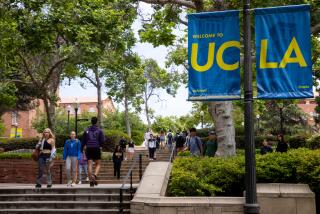Tens of thousands of California college students to get relief from emergency grants

- Share via
The text messages and email blasts went out to 5,500 Pasadena City College students last week. “Congratulations!” they said. “You have been awarded a Federal CARES Emergency Grant.”
Within 24 hours 4,500 students had accepted.
Lizette Hernandez, 21, was one of them. Hernandez, who shares a two-bedroom apartment in Rosemead with six relatives, said most of the adults in her household had been laid off, leaving her mother the main breadwinner. The $1,000 Hernandez will receive will help feed her family, including two siblings, 14 and 4 years old.
“She feels really blessed that we could receive this grant,” Hernandez said of her mother.
Tens of thousands of students across California like Hernandez are eligible for emergency coronavirus grants through the federal CARES Act signed into law March 27. As colleges receive funds, they are attempting to disperse aid among widespread need.
The legislation sets aside $14 billion for higher education emergency relief. California higher education institutions are slated to get $1.7 billion — including $580 million for the California Community Colleges, $525 million for the California State University and $260 million for the University of California.
At least half of the money must go directly to students for emergency aid, and only students eligible for federal financial aid qualify.
The money is deeply needed, particularly in the community college system, where an estimated half of students had experienced food insecurity, and one in five had dealt with homelessness before the pandemic.
The pandemic’s toll: Lives lost in California
Hundreds of people have died in California due to the COVID-19 pandemic. These are some of their stories.
Colleges have significant discretion in determining how to divide the money, and among whom. Students should contact their campus financial aid office if they have questions.
Cal State grants
At the Cal State schools, students are generally being grouped into three categories to determine grant awards, said Luoluo Hong, associate vice chancellor for student affairs and enrollment management. They are:
- Students who have the lowest income status and received the maximum amount of federal and/or state aid.
- Students who received some financial aid.
- Students who did not receive financial aid but who may have need arising from the pandemic.
The first two groups will receive automatic grants, with the needier students receiving higher amounts. Both groups may apply for more. The third group can apply for aid through a short online form, with priority deadlines later this month. It’s up to each campus to decide who falls into each tier and to set the grant amounts.
At Cal State Stanislaus more than half of the 10,600 enrolled students will receive automatic grants of between $350 and $1,200, depending on their financial need and full-time or part-time status, said Noelia Gonzalez, assistant vice president for enrollment management.
Others can apply, perhaps for $200 if all they need is help paying for books, or $2,000 if they are struggling with rent and food, Gonzalez said.
“I’m confident this will hit the greatest number of students with the best amount of funding,” she said.
At Cal State Fullerton, which was allocated $41 million in federal aid, including just over $20 million for students, typical grants will range from $400 to $900. At Cal State Northridge, which received close to $45 million, students must sign on to their online portal to accept grants that range from $308 to $968 or apply for a higher amount.
Adriana Fernandez, 21, a junior at Cal State Fullerton, lives at home in Garden Grove with her parents and two college-age siblings. Everyone has lost work. The children share one laptop and do schoolwork from their cellphones, straining the available bandwidth.
“Any amount would be helpful in this situation,” Fernandez said. She would use her grant for bills and possibly pool it with her siblings to upgrade their internet connection, buy noise-canceling headphones or invest in a tablet or another computer so they could study more easily, she said.
UC grant applications
The timing and distribution of grants at UC will vary by campus, said Sarah McBride, spokeswoman for the UC Office of the President.
Generally, the awards will be distributed based on the campus assessment of local need, McBride said. That could include funds for financial aid adjustments to students whose households have been affected by the economic downturn.
At UCLA all eligible students who are enrolled at least half-time may receive a grant of $200 from the CARES program. They must complete an affidavit online by May 22 to verify that they are eligible for federal financial aid and have expenses related to COVID-19.
Additional need-based grants ranging from $200 to $1,850 will be distributed, with higher amounts given to members of vulnerable populations who have financial need, including former foster youth, homeless or housing-insecure students and students with disabilities. UCLA students may also opt out of receiving their funds to donate their share to peers.
At UC Irvine, more than 17,000 students will receive CARES funding, interim provost Hal Stern said. University officials created five tiers of funding, ranging from $500 to $1,500, that take into account whether students are dependents or considered financially independent and if they have children — in addition to their financial aid and expected family contribution.
“Our guiding principles were to get money to the neediest populations we could identify. And make the process as easy as possible,” Stern said.
Community college applications
At the California Community Colleges, where almost half of the 2.1 million enrolled students qualify for tuition fee waivers, campuses are taking various approaches.
Pasadena City College sought to support students who are disadvantaged not only by income, but also in other ways, such as having been incarcerated or in the foster system. To notify the 1,000 students who didn’t immediately accept their grants, staff members started picking up the phones.
The school is also saving some of its money to award a possible second round of grants and to give students cash assistance for food.
At the Los Angeles Community College District, 44,000 eligible students will automatically receive $300 grants, with additional money being awarded through an as-yet-undetermined application process, spokesman William Boyer said.
Students said the emergency aid, no matter the amount, would be welcome.
Victor Melendez, who attends Los Angeles Trade Tech College, works two part-time jobs to help feed his family, buy diapers for a younger brother and pay his mother’s phone bill. Even before the pandemic, Melendez, 24, relied on his campus’ food pantry. Amid business closures, his mother lost work cleaning restaurants.
With an additional $300, “I would definitely buy groceries for myself,” he said from his Pico-Union apartment. “I’d buy a big bag of rice and canned food so it could last me a longer time. And I would do the same thing for my family.”
Michael Duggan, a formerly homeless student at L.A. City College, subsists on roughly $200 monthly in General Relief, a cash aid program, and food stamps, which cover about three weeks of groceries.
A $300 check would help Duggan pay off utility bills that have been piling up. The rest, he said, “would go into a teeny, tiny emergency fund” to help buy food during what he calls “hell week.”
The money won’t last long, though.
“A one-time check is not going to be enough for something that could continue until 2021,” said Amine El Moznine, vice president of legislative affairs for the Student Senate of the California Community Colleges.
No grants for undocumented students
Some students, including immigrants without permanent residency, will be left out of the federal aid program. Colleges said they hope to support those students with other money but acknowledged they may not have enough.
Trish Martinez, 31, started at Cal State Fullerton in 2014. A “Dreamer” who has work authorization through the Deferred Action for Childhood Arrivals program, Martinez worked as a barista throughout college to support her son and commuted 12 miles by bike to campus to save money.
This semester she had a paid internship on campus, but that will end when she graduates this month.
Martinez’s mother lost her job cleaning houses, which put pressure on Martinez to come up with their full rent. She has relied on food pantries and neighbors, friends and even her boss for groceries.
“I’m just going to keep looking for a job,” she said.
More to Read
Sign up for Essential California
The most important California stories and recommendations in your inbox every morning.
You may occasionally receive promotional content from the Los Angeles Times.











